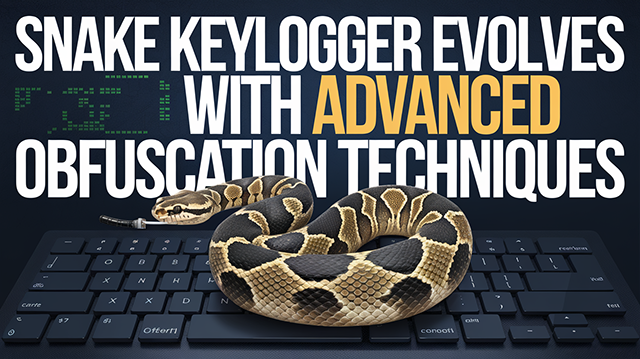Snake Keylogger Evolves with Advanced Obfuscation Techniques

Threat Group: Unidentified Cybercriminal Group
Threat Type: Keylogger/Information Stealer
Exploited Vulnerabilities: No specific vulnerabilities exploited; relies on social engineering and phishing techniques
Malware Used: Snake Keylogger (New Variant)
Threat Score: High (8.5/10) – Due to its advanced obfuscation techniques, persistence mechanisms, and widespread targeting
Last Threat Observation: February 20, 2025
Overview
A new variant of the Snake Keylogger malware has been identified, actively targeting Windows users across multiple regions, including China, Turkey, Indonesia, Taiwan, and Spain. Since the beginning of 2025, this variant has been responsible for over 280 million blocked infection attempts worldwide, underscoring its extensive reach and the significant threat it poses.
Key Details
- Delivery Method: Phishing emails containing malicious attachments or links
- Target: Windows users, with a focus on individuals in China, Turkey, Indonesia, Taiwan, and Spain
- Functions:
- Keystroke logging to capture user inputs
- Credential harvesting from popular web browsers such as Chrome, Edge, and Firefox
- Clipboard data monitoring
- Screenshot capturing
- Exfiltration of stolen data via SMTP (email) and Telegram bots
- Obfuscation: Utilizes AutoIt scripting language to compile the payload, adding a layer of obfuscation that complicates static analysis and mimics legitimate automation tools
Attack Vectors
The infection chain typically begins with phishing emails that entice recipients to open malicious attachments or click on links leading to the download of the malware. Upon execution, the malware performs the following actions:
- Payload Deployment: The malicious attachment, often an AutoIt-compiled executable, is executed on the victim's system.
- Persistence Mechanism: The malware copies itself as "ageless.exe" into the
%LocalAppData%\supergroupdirectory and creates a Visual Basic Script (VBS) file named "ageless.vbs" in the Windows Startup folder. This ensures the malware runs automatically upon system reboot without requiring administrative privileges. - Process Injection: Employing a technique known as process hollowing, the malware injects its payload into a legitimate .NET process, such as
RegSvcs.exe. This involves spawning the process in a suspended state, replacing its code with malicious code, and then resuming the process to evade detection. - Data Exfiltration: The malware logs keystrokes, captures screenshots, monitors clipboard data, and retrieves saved credentials from web browsers. The collected data is then exfiltrated to the attacker's command-and-control server using SMTP and Telegram bots.
Potential Impact
- Data Breaches: The keylogger's ability to capture sensitive information, including login credentials, financial data, and personal communications, can lead to severe data breaches.
- Financial Loss: Stolen financial information can be used for identity theft, fraudulent transactions, and unauthorized access to bank accounts.
- Reputation Damage: Data breaches can tarnish an organization's reputation, leading to loss of customer trust and potential legal consequences.
- Espionage: Advanced threat actors may utilize keyloggers to gather intelligence on specific individuals or organizations.
Known Indicators of Compromise (IoCs)
URLs
Files Hashes (MD5)
- f8410bcd14256d6d355d7076a78c074f
- f8410bcd14256d6d355d7076a78c074f
- 77f8db41b320c0ba463c1b9b259cfd1b
Advanced Mitigation Strategies
In addition to the recommended measures, consider these advanced strategies:
- Endpoint Detection and Response (EDR): Implement EDR solutions to proactively detect and respond to malicious activities, including keylogger installations and data exfiltration attempts.
- Behavioral Analytics: Utilize behavioral analytics tools to identify anomalous user behavior that may indicate a compromise, such as unusual login patterns or data transfer activities.
- Network Traffic Analysis: Monitor network traffic for suspicious patterns, such as encrypted communication channels used by the malware to exfiltrate data.
- Security Awareness Training: Conduct regular and comprehensive security awareness training to educate employees about phishing tactics, social engineering techniques, and best practices for secure computing.
- Zero-Trust Security Model: Adopt a zero-trust security model, which assumes that no one is inherently trustworthy. This approach involves continuous verification and authorization of users and devices, reducing the risk of unauthorized access.
Future Trends
As cybercriminals continue to innovate, we can expect to see more sophisticated keylogger variants emerge. Some potential future trends include:
- AI-Powered Keyloggers: Keyloggers leveraging artificial intelligence to adapt to user behavior and evade detection.
- Mobile Keyloggers: Targeting mobile devices, including smartphones and tablets.
- Cloud-Based Keyloggers: Storing stolen data in cloud storage services to avoid detection.
Conclusion
The Snake Keylogger variant poses a significant threat to individuals and organizations. By understanding its capabilities, potential impact, and advanced mitigation strategies, organizations can bolster their security posture and protect sensitive information. Staying informed about the latest threats and adopting a proactive approach to cybersecurity is crucial in today's digital landscape.
Sources:
- Fortinet - FortiSandbox 5.0 Detects Evolving Snake Keylogger Variant
- The Hacker News - New Snake Keylogger Variant Leverages AutoIt Scripting to Evade Detection
- Infosecurity Magaxine - Evolving Snake Keylogger Variant Targets Windows Users


